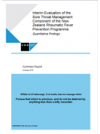This interim evaluation assessed the sore throat management component of the Rheumatic Fever Prevention Programme from the baseline years (2009 to 2011) up to June 2015. A final overall technical report of the interim evaluation and a shorter summary version is available in the downloads column of this page.
Purpose
- Assess the effectiveness of the sore throat management component on reducing the incidence of acute rheumatic fever in priority children and young people (in particular Māori and Pacific communities with high acute rheumatic fever).
- Assess the effect of the Rheumatic Fever Prevention Programme on targeting sore throat management to children at high risk of developing acute rheumatic fever.
- Determine the extent to which acute rheumatic fever cases are successfully identified and swabbed in the sore throat management services.
- Evaluate the cost effectiveness of school-based sore throat management services.
- Provide conclusions to guide future investment decisions in sore throat management services.
Methodology
This interim evaluation used quantitative methods, including an effectiveness analysis and a cost-effectiveness analysis. The data included:
- routine acute rheumatic fever first episode hospitalisations
- acute rheumatic fever notifications
- laboratory throat swab results for the target age groups 5–12 years and 13–19 years.
A cohort design was used to assess the effectiveness of the school-based programme and a ‘what if’ analysis involving a semi-Markov model was used to assess cost-effectiveness.
Key Results
- By June 2015 at a total population level, there was a statistically significant national decline of 27% in hospitalisations for first episode rheumatic fever compared to the baseline years (2009 to 2011) when the Rheumatic Fever Prevention Programme began. There was a statistically significant decline of 32% in rheumatic fever first episode hospitalisations for 5–12-year-olds for the same period.
- There was a statistically significant decline of 26% in first episode rheumatic fever notifications for children aged 5–12 years in the 10 DHBs where the school-based services have been implemented from the baseline years (2009–2011) to June 2015. There was a statistically significant decline of 40% in young people aged 13–19 years who are largely not covered by the school-based services. Consequently, it is difficult to attribute this decline solely to exposure to the school-based services.
- The analysis of the effectiveness of the school-based services in the 10 DHBs that have implemented this service showed an overall decline of 17% in acute rheumatic fever cases attending schools offering the school-based sore throat management service. This decline was not statistically significant. For Counties Manukau DHB, the decline was larger at 31% but was also not statistically significant. These findings may reflect the fact that the evaluation only had adequate statistical power (85%) to detect levels of effectiveness of 50% or more. Another year of data may help determine whether these downward trends are sustained and become statistically significant.
- The school-based services appear effective at targeting throat swabbing to high-risk populations attending schools.
- The cost-effective analysis indicated that for Counties Manukau DHB, where the incidence of rheumatic fever is high (87 per 100,000) and the effectiveness is 30%, the school-based service is cost-effective under WHO criteria, but not under PHARMAC standards. The school-based service could not be considered cost-effective in other DHBs.
- Some aspects of the school-based services could be further strengthened, including timely initiation of antimicrobial treatment, and further improved antibiotic adherence.
- The school-based services alone will not be adequate to achieve the BPS target of reducing the incidence of first episode rheumatic fever hospitalisations by two-thirds by 2017.


